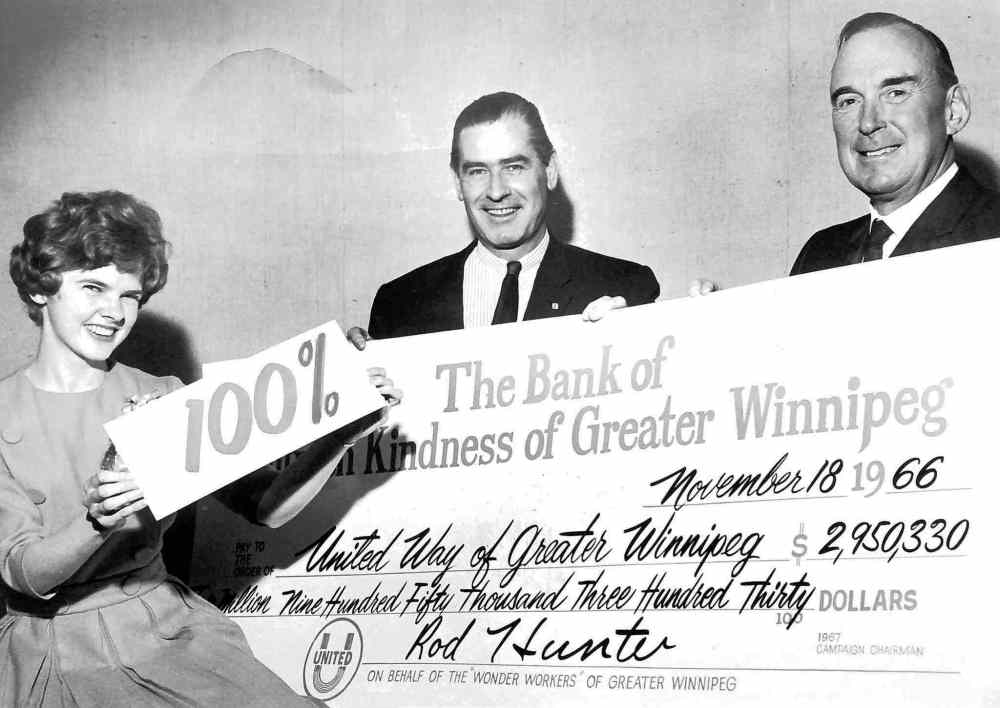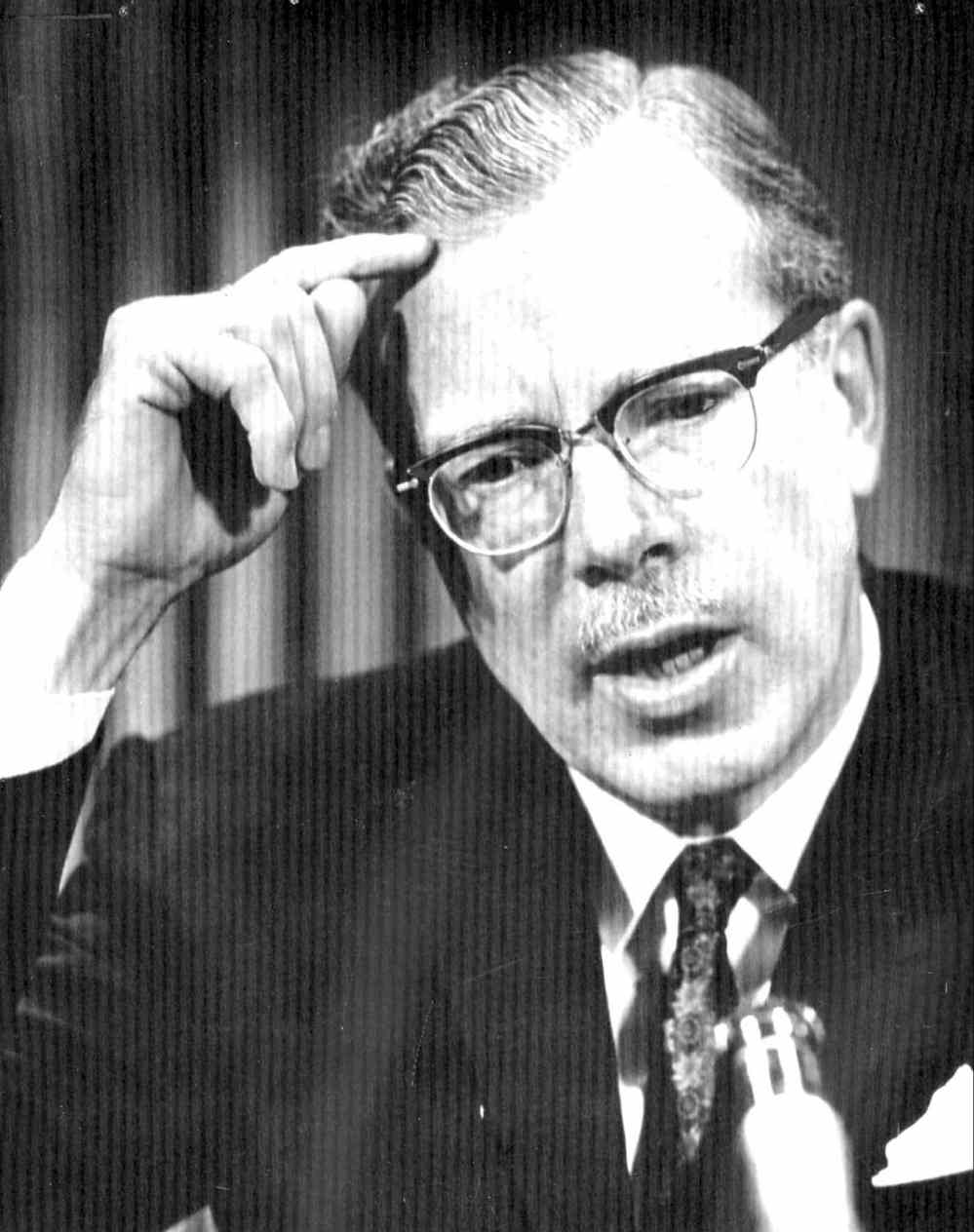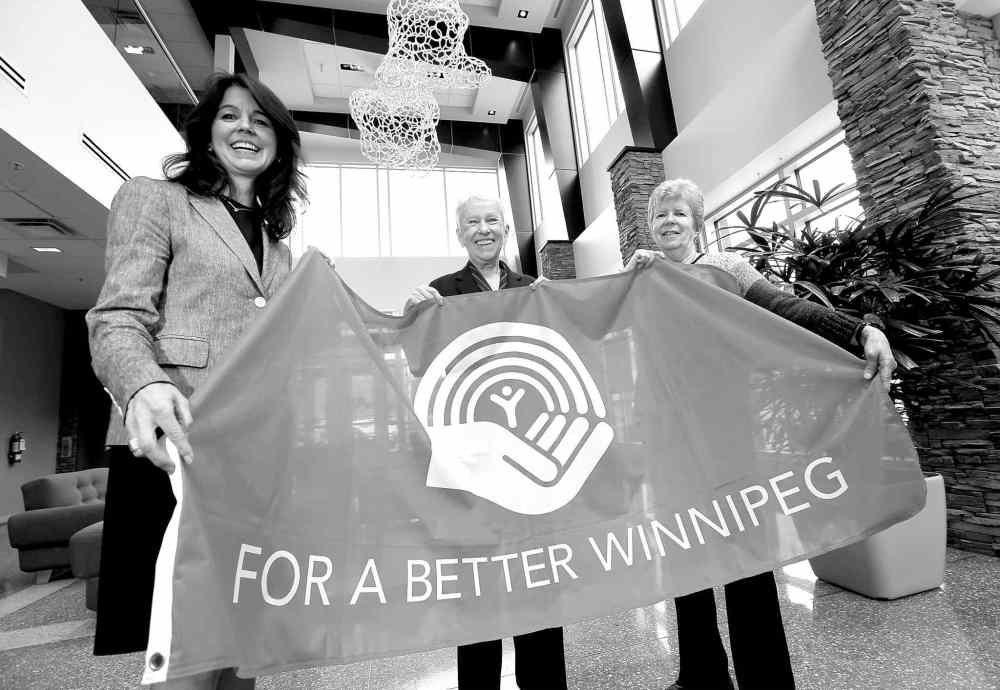Fifty years of FUNDRAISING
United Way changed the way Winnipeggers donate
Advertisement
Read this article for free:
or
Already have an account? Log in here »
To continue reading, please subscribe:
Monthly Digital Subscription
$0 for the first 4 weeks*
- Enjoy unlimited reading on winnipegfreepress.com
- Read the E-Edition, our digital replica newspaper
- Access News Break, our award-winning app
- Play interactive puzzles
*No charge for 4 weeks then price increases to the regular rate of $19.00 plus GST every four weeks. Offer available to new and qualified returning subscribers only. Cancel any time.
Monthly Digital Subscription
$4.75/week*
- Enjoy unlimited reading on winnipegfreepress.com
- Read the E-Edition, our digital replica newspaper
- Access News Break, our award-winning app
- Play interactive puzzles
*Billed as $19 plus GST every four weeks. Cancel any time.
To continue reading, please subscribe:
Add Free Press access to your Brandon Sun subscription for only an additional
$1 for the first 4 weeks*
*Your next subscription payment will increase by $1.00 and you will be charged $16.99 plus GST for four weeks. After four weeks, your payment will increase to $23.99 plus GST every four weeks.
Read unlimited articles for free today:
or
Already have an account? Log in here »
Hey there, time traveller!
This article was published 09/05/2015 (3854 days ago), so information in it may no longer be current.
Where there’s a will there’s a way — a United Way, that is.
For 50 years, the United Way of Winnipeg, emerging from the closure of the Community Chest and through the help of willing Winnipeg donors, has been helping Winnipeggers in need.
Next week, the organization is going to reveal how it will celebrate the milestone, but here is a look back at where it has been and where it is going.

Arthur Mauro, who went on to became president and CEO of Investors Group, was a lawyer in 1964 when he became the final chairman of the Winnipeg Community Chest. The Community Chest was created in 1919 by what today is called the Social Planning Council of Winnipeg.
“I’d been on the board for a number of years when I became chair,” Mauro recalled recently.
“We had started some work with the idea of creating a broader appeal than the Community Chest. I forget when the United Way started being developed here, but I knew there was a group that was working on it.
“The important thing was to get a much greater involvement of the labour group into the whole process.”
The United Way was formed by the Winnipeg Labour Board and the Winnipeg Chamber of Commerce with a mandate to provide funding for “non-profit charitable, benevolent, health and welfare organizations in a more adequate manner than the former method involving many independent appeals for funds.”
Mauro said part of the problem with the Community Chest was, while hundreds of volunteers, mostly women, would fan out across the city to go door-to-door asking for donations, there were other organizations that did the same.
“We were trying to get as many of the groups into the Community Chest as we could to try to minimize the number of appeals out there,” he said.
Mauro joined the fledgling United Way in its first year. His name is in the United Way’s first annual report as a member of the admissions committee.
In its first year, the United Way’s 1965 campaign set a goal of $2.5 million, almost double the $1.3 million campaign goal of the Community Chest the year before that had fallen slightly short, raising 98.6 per cent.
While the Community Chest helped fund 40 organizations, the United Way hoped to not only help them, but other organizations that had never been part of it. In the end, 50 organizations were funded from the first campaign, with the Society for Crippled Children and Adults, now the Society for Manitobans with Disabilities, the first non-Community Chest agency to join.
While the first campaign raised $2.76 million, United Way staff already knew the next year’s goal had to be even higher, because it had to cut $260,000 from agency requests.
The United Way has since grown to raising $19.7 million to support 104 agencies in 2011 and raised $20 million for the first time in 2013.
Mauro said the main difference is the way the United Way raises funds today. He said during the first campaign, a lot of the money it raised still came from canvassing.
“Those days, they went door-to-door, but now, with payroll deductions and the active involvement of corporations and their employees, it is much grander,” he said.
‘It is my sincere wish that the United Way will readily become the accepted way in which citizens of the community will choose to support the charitable agencies your organization will represent. Consequently, I am sure they will welcome the concept of ‘unity in giving.’ May I wish you every success’
— premier Duff Roblin in a statement after the United Way was officially incorporated in Winnipeg on May 11, 1965.
Many politicians and prominent people of the time applauded the creation of the United Way in Winnipeg.
Then-prime minister Lester Pearson said, “I am confident that by planning, budgeting, raising funds and working together… the United Way, Greater Winnipeg citizens will help to build a better community and a greater Canada.”
NDP leader Tommy Douglas called the United Way “the best alternative to a multiplicity of appeals and deserves the support of all Canadians whose cities have adopted this approach.”
Claude Jodoin, president of the Canadian Labour Congress, said his organization “has always favoured the United Way of charitable giving as being the most satisfactory alternative to a multiplicity of uncoordinated appeals.”
After the first United Way campaign was completed, Alex Robertson, president of its board of trustees, said, “Like the explorers of old, we have just touched on the shores of our new world — our new United Way.
“Each year, new companies of explorers will come to know the joy and pain of pursuing new visions, breaking new paths and conquering new lands.”
Carole McGonigal had been a fundraising volunteer at both the Community Chest and the Canadian Red Cross when she began helping the United Way. She later served on the organization’s board.
“In 1965, we did the Red Cross campaign in the spring and the United Way in the fall,” McGonigal said. “There was a great network of volunteers who worked on the campaigns.”
McGonigal said she was in charge of canvassing suburban neighbourhoods in the city during the first United Way campaign, including Fort Garry and Charleswood.
“Times have changed — there’s not many people who would be available to do that now,” she said. “Even the Cancer Society used to do it. I haven’t had anybody knocking at my door for four to five years now.
“It was truly amazing that first year. We raised over $2.7 million in the first campaign. It would be interesting to know what that is, comparing 1965 dollars to 2015 dollars.”
Taking inflation into account, $2.76 million had the same buying power as $20.8 million today. Connie Walker, the current CEO of the United Way, said she has done the same math.
“It’s a signal to me — the needs are great,” Walker said. “And there’s still lots to be done.”

Walker said when she examines the organization’s first annual report — and then looks at what it does now — she sees many similarities, but also several differences.
“Hope and pride; I still see that here. How strong the role of volunteers are. Volunteers still are part of what we do today.
“A lot of the fundraising hasn’t changed… it’s shifting to continue to provide dollars to agency partners, but also look at new ways, too.”
Walker said one difference is, instead of providing annual funding to an organization, the United Way now sets up three-year contracts with them so they can count on stable funding.
And Walker points to the 10-year plan to end homelessness task force set up last year as an example of the United Way’s new way of doing things.
“You really want to see progress on these issues,” she said.
Walker said 100 volunteers in teams of three go out annually to agencies they fund to check on them.
“They ask all the questions our donors would like to ask if they were there,” she said. “The agencies appreciate it. The questions they ask helps make the agencies stronger.”
Thanks to the provincial government, no donor dollars are used for administration or fundraising.
“It’s fantastic — it means the world to us,” Walker said.
For its first decades, the United Way was pretty simple. Donations came in and were paid to agencies as grants.
Starting in the 1990s, the process began changing, with sustained funding going to agencies in multi-year agreements and the United Way becoming an entity that looked at helping root causes for issues in the community, such as homelessness.
Susan Lewis worked with the United Way for four decades, starting as a campaign manager in 1974 and rising to president in 1985 before retiring last year.
Lewis said she knows why the United Way is still successful five decades after it began here.

“Very, very strong community leadership has kept it together,” she said. “They have led the organization at both a board level and also at a volunteer level. A lot of them were visionaries and very connected to change in the community.
“They helped the United Way stay relevant.”
She credits former Winnipeg Free Press editor Margo Goodhand for pushing the homelessness strategy into fruition.
“She was like a dog with a bone and kept saying homelessness is not acceptable in our city and we must do something about it,” Lewis said.
“It was Margo’s drive which moved it to where it is today.”
Lewis said if people can be given a place to live, then many of the dollars both government and the United Way puts into various programs can be diverted to helping solve other problems.
Mauro said the United Way has been around for 50 years, and he knows it will be around for many more.
“It is a wonderfully successful organization,” he said. “It is our community spirit that has allowed it to grow.
“We can be very proud of what we have here.”
kevin.rollason@freepress.mb.ca

Kevin Rollason is a general assignment reporter at the Free Press. He graduated from Western University with a Masters of Journalism in 1985 and worked at the Winnipeg Sun until 1988, when he joined the Free Press. He has served as the Free Press’s city hall and law courts reporter and has won several awards, including a National Newspaper Award. Read more about Kevin.
Every piece of reporting Kevin produces is reviewed by an editing team before it is posted online or published in print — part of the Free Press‘s tradition, since 1872, of producing reliable independent journalism. Read more about Free Press’s history and mandate, and learn how our newsroom operates.
Our newsroom depends on a growing audience of readers to power our journalism. If you are not a paid reader, please consider becoming a subscriber.
Our newsroom depends on its audience of readers to power our journalism. Thank you for your support.



